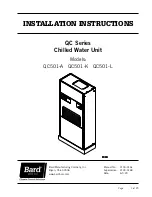
20
Standing Vacuum Test
When performing the standing vacuum test or chiller dehydration,
use a manometer or a wet bulb indicator. Dial gages cannot indi-
cate the small amount of acceptable leakage during a short period
of time.
1. Attach an absolute pressure manometer or wet bulb indica-
tor to the chiller.
2. Evacuate the vessel to at least 18 in. Hg vac (41 kPa [abs]),
using a vacuum pump or a pumpout unit.
3. Valve off the pump to hold the vacuum and record the
manometer or indicator reading.
a. If the leakage rate is less than 0.05 in. Hg (0.17 kPa) in
24 hours, the chiller is sufficiently tight.
b. If the leakage rate exceeds 0.05 in. Hg (0.17 kPa) in
24 hours, re-pressurize the vessel and test for leaks.
4. Repair the leak, retest, and proceed with dehydration.
Check the Installation
Use the following instructions to verify the condition of the
installation. Note that the contractor should not apply power
to the chiller before the Carrier Start-up Technician arrives at
the job site.
1. Inspect the water piping to the chiller to confirm it is cor-
rect. Confirm it is adequately supported from the chiller
and there are isolation valves installed.
2. Turn off, lock out, and tag the input power to the drive.
3. Wait a minimum of 8 minutes (for Danfoss Drive) for the
DC bus to discharge.
4. All wiring should be installed in conformance with the
applicable local, national, and international codes (e.g.,
NEC/CSA).
5. Remove any debris, such as metal shavings, from the
enclosure.
6. Check that there is adequate clearance around the
machine.
7. Verify that the wiring to the terminal strip and the power
terminals is correct and that no external voltage potential
is connected to any of the inputs.
8. Verify that all of the VFD power module circuit board con-
nectors are fully engaged and taped in place.
9. Check that the field-installed wire size is within terminal
specifications and that the wires are tightened properly and
adequately supported.
10. Check that specified branch circuit protection is installed
and correctly rated.
11. Check that the incoming power is within ±10% of chiller
nameplate voltage.
12. Verify that a properly sized ground wire is installed and a
suitable earth ground is used. Check for and eliminate any
grounds between the power leads. Verify that all ground
leads are unbroken to the power supply. Only a wye sec-
ondary power supply transformer with solidly grounded
neutral is acceptable as a power supply to this chiller. If a
ground wire is not present or the transformer secondary is
any other type than a wye with solidly grounded delta,
please contact the Technical Service Manager or Service
Engineering.
Inspect Wiring
1. Examine the wiring for conformance to the job wiring dia-
grams and all applicable electrical codes.
2. Ensure that the VFD is protected by fused disconnects or
circuit breakers as per electrical code.
3. Compare the ampere rating on the VFD nameplate to rat-
ing on the compressor nameplate.
4. Check that there is adequate service clearance around the
machine.
5. Check that specified branch circuit protection is installed
and correctly rated.
6. Ensure there is capability to turn off, lock out, and tag the
input power to the drive.
7. If power is applied to the drive then wait for the DC bus to
discharge and check DC bus voltage prior to starting any
work. FC-102 drives have a label that indicates the capaci-
tor discharge time dependent on drive sizes.
8. Inspect the control panels and VFD enclosure to ensure
that the contractor has used the knockouts or provided top
hat to feed the wires into the enclosures. Generally, wiring
into the top of the enclosures can allow debris to fall into
the enclosures. Clean and inspect the interior of the power
panel and VFD enclosure if this has occurred. If metal par-
ticulate has fallen into the rectifier or inverter assemblies
contact Service Engineering or your Technical Service
Manager for further instructions.
9. Check that the incoming power is within ±10% of chiller
nameplate voltage.
10. Check that the room environmental conditions match the
chiller enclosure type. If the installation location does not
have four walls and a roof, please contact the Technical
Service Manager or Service Engineering.
11. Ensure the customer’s contractor has verified proper oper-
ation of the pumps, cooling tower fans, and associated
auxiliary equipment. This includes ensuring motors are
properly lubricated and have proper electrical supply and
proper rotation. The chiller or the building automation sys-
tem must be capable of establishing water flow when the
unit is in operation or off line for the freeze protection
algorithm in the chiller controls to be effective. Pump con-
trol must be maintained for freeze protection algorithm.
12. Verify that the incoming source does not exceed the SCCR
(short circuit current rating) of the equipment marking.
13. Ensure all electrical equipment and controls are properly
grounded in accordance with the job drawings, certified
drawings, and all applicable electrical codes.
WARNING
Do not check the voltage supply without proper equipment
and precautions. Serious personal injury may result. Follow
power company recommendations.
CAUTION
Do not apply any kind of test voltage, even for a rotation
check, if the chiller is under a dehydration vacuum. Insulation
breakdown and serious damage may result.
WARNING
Do not apply power unless a qualified Carrier technician is
present. Serious personal injury may result.
Содержание AquaEdge 19MV
Страница 49: ...49 Fig 46 SIOB...
Страница 50: ...50 Fig 47 IOB2...
Страница 51: ...51 Fig 48 19MV Auxiliary Controls Wiring...
Страница 52: ...52 Fig 49 Motor Bearing Control Board Wiring...
















































